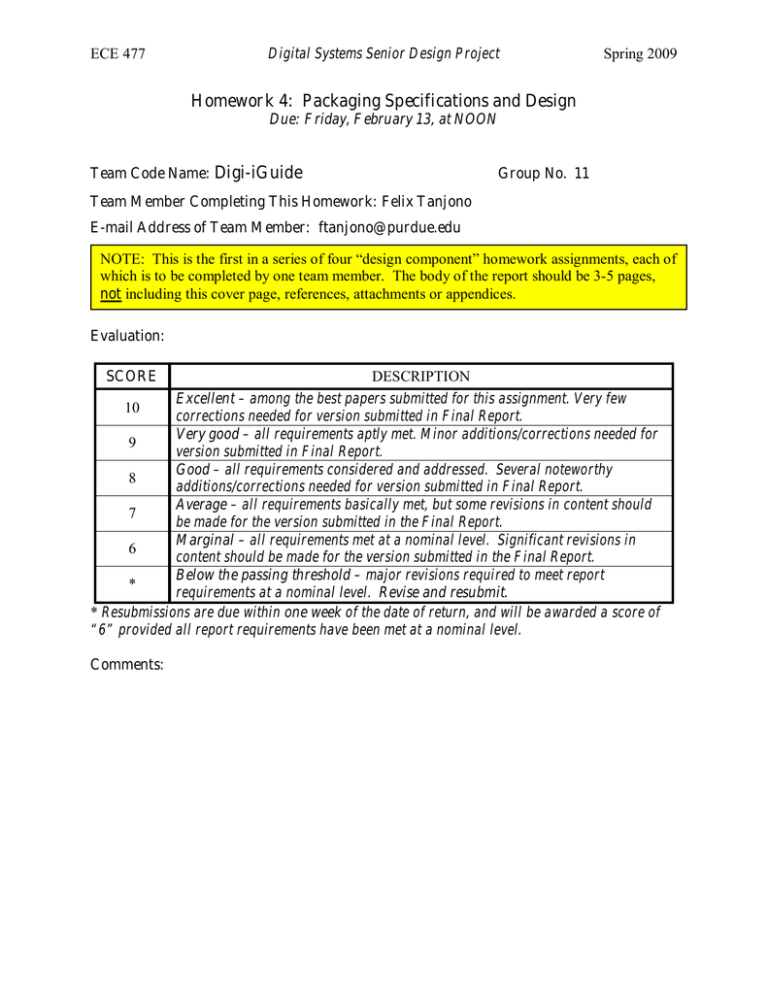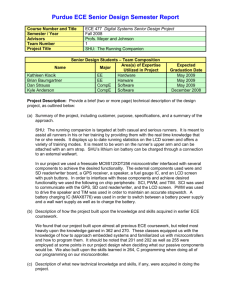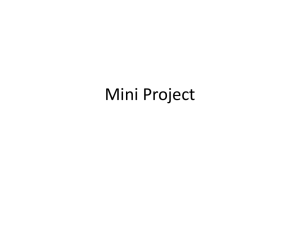Homework 4: Packaging Specifications and Design
advertisement

ECE 477 Digital Systems Senior Design Project Spring 2009 Homework 4: Packaging Specifications and Design Due: Friday, February 13, at NOON Team Code Name: Digi-iGuide Group No. 11 Team Member Completing This Homework: Felix Tanjono E-mail Address of Team Member: ftanjono@purdue.edu NOTE: This is the first in a series of four “design component” homework assignments, each of which is to be completed by one team member. The body of the report should be 3-5 pages, not including this cover page, references, attachments or appendices. Evaluation: SCORE DESCRIPTION Excellent – among the best papers submitted for this assignment. Very few corrections needed for version submitted in Final Report. Very good – all requirements aptly met. Minor additions/corrections needed for 9 version submitted in Final Report. Good – all requirements considered and addressed. Several noteworthy 8 additions/corrections needed for version submitted in Final Report. Average – all requirements basically met, but some revisions in content should 7 be made for the version submitted in the Final Report. Marginal – all requirements met at a nominal level. Significant revisions in 6 content should be made for the version submitted in the Final Report. Below the passing threshold – major revisions required to meet report * requirements at a nominal level. Revise and resubmit. * Resubmissions are due within one week of the date of return, and will be awarded a score of “6” provided all report requirements have been met at a nominal level. 10 Comments: ECE 477 Digital Systems Senior Design Project Spring 2009 1.0 Introduction The premise of the iGuide is a device that will be used by student in the open area to find their way through the campus, it will help them by plotting out the shortest path to get from their current location to a location they specify. With this in mind, the device’s form factor needs to be easily carried around and strong enough to withstand drop from at least waist-level. In order to bring the cost down, the outer packaging will most likely be plastic, which will maximize GPS reception as well. 2.0 Commercial Product Packaging 2.1 Product #1 - iPhone The first product that resembles the packaging of our final product is the Apple’s secondgeneration iPhone [1]. The face of the device consists of a 3.5” glass widescreen touch display with a capacitive touch screen and a single physical button. The interface is packaged in plastic with metallic bezel on the edge of the device. The total weight of the device is 4.7 ounces (133 grams). It uses a non-removable rechargeable lithium-ion battery for its power. -1- ECE 477 Digital Systems Senior Design Project Spring 2009 The main advantage of this product is the simplicity of the design. The minimal use of physical buttons ensures ease of use, and most of the interfacing is focused on the touch screen. The size and weight of the device also makes it ideal for a hand-held use. On the other hand, the nonremovable battery is a downside. It prevents customers from replacing the battery easily without specialized tools. Aspects of iPhone that might be used in our final design include the look and the package material. We want to use as few physical buttons as possible (probably none), focusing the interfacing instead in the touch-screen. The design of the screen’s interface will be essential in making this work well. We will most likely use plastic for the casing like the iPhone. It is a cheaper alternative and less disruptive to the GPS signal than a metallic material like aluminum. We also want the size and weight of the package to resemble that of the iPhone as closely as possible, though our device will not be as thin. Our device will differ from the iPhone by having a removable back plate, which will both simplify debugging and provide means for the user to replace the battery. 2.2 Product #2 – Garmin Nuvi 200 Our device will also be similar in packaging to the Garmin nüvi 200. The nüvi package is 3.8" wide by 2.8" high and 0.8” deep. Like the iPhone, the user’s primary means of interfacing with the nüvi is via the touch screen, however the nüvi has a resistive touch screen and includes a power switch on the top of the device. The device has a non-removable rechargeable lithium-ion battery and weighs 5.2 ounces. -2- Digital Systems Senior Design Project ECE 477 Spring 2009 Much like the iPhone, the nüvi has a simple design that capitalizes on the use of touch interfacing instead of physical buttons. The unit’s size makes it extremely portable and flexible for use either in a vehicle or in hand. The nüvi, like the iPhone, does not give the user the option of easily removing the battery, which is not optimal. We plan on having a very similar design to the nüvi. Our touch screen will be our primary input source, and we do not plan on having any other inputs. Our device will have to be hand-held as well since our users will exclusively be pedestrians. Our packaging will be different from the nüvi since we will have a means for the user to remove the back plate and replace the battery. Our device will also feature a smaller touch screen so we will most likely have a smaller surface area, however our device will be thicker. 3.0 Project Packaging Specifications Our product’s packaging will consist of a plastic shell containing the printed circuit board and battery, with the LCD screen positioned centered in the top. The LCD screen will be held into place with screws fastened through supporting tabs built into the display's PCB. The back plate of the shell will be removable in order to provide the user with access to the battery. Since the packaging will be plastic, we will not require any complex tooling beyond screwdrivers, some type of saw, and a drill. 4.0 PCB Footprint Layout Name Dimension (mm x mm) Area (mm2) Flash 10 x 10 100 USB receptacle 13.9 x 16 222.4 C8051 8.9 x 8.9 79.21 PIC32 10 x 10 100 LCD header 6.9 x 2.7 18.63 GPS connector 5 x 1.9 9.5 Power Circuits ~25.4 x 25.4 ~645.16 It is important for the entire component to fit on the board and given reasonable space to work correctly. The major components of our board will be made up of flash chips, USB receptacle. -3- ECE 477 Digital Systems Senior Design Project Spring 2009 C8051 and PIC32 chip, LCD header, GPS connector and the power circuits. The USB receptacle will most likely be placed along the edge of the PCB to allow easy access, the LCD header needs to be placed in the middle so that it can easily connect with the LCD module, the GPS connector might best be placed far away from the other components so that the GPS signal will not get disrupted or weaken by potential internal radiation. From the table above, when the PCB footprints of each components is measured and placed together to scale, we found that it will fit in a PCB roughly the size of 6¼” x 4¾” (refer to Appendix C), the final size might change a little due to additional components like capacitor, resistor. The device is internally designed such that the PCB is sandwiched in between the LCD and the battery. With this in mind, the power circuitry will most likely be placed on the second layer facing the battery while the rest of the components will be placed on the first facing the back of the LCD. Through this setup, the LCD and the battery connection can easily be made without complicated wiring involved. 5.0 Summary The packaging design for our project is intended to be similar to products such as the Apple iPhone or the Garmin nüvi. We will have a touch screen that provides the main interface between the user and the device, and it will be packaged in a portable, hand-held casing powered by a Lithium-ion battery. The dimension of the final product will be roughly 2¼” x 3” x 1”. -4- ECE 477 Digital Systems Senior Design Project Spring 2009 List of References [1] “iPhone 3G,” [Online Document], 2009, [cited 2009 Feb 11], Available HTTP: http://www.apple.com/iphone [2] “nüvi® 200,” [Online Document], 2009, [cited 2009 Feb 11], Available HTTP: www.garmin.com/products/nuvi200 [3] ECE 4777 Spring 2009 Group 11 “Design Project Proposal and Specifications,” [Online Document], 2009 Jan 23, [cited 2009 Feb 11], Available HTTP: https://engineering.purdue.edu/477grp11/wp-content/uploads/2009/01/hw0212.doc -5- ECE 477 Digital Systems Senior Design Project Appendix A: Project Packaging Illustrations -6- Spring 2009 ECE 477 Digital Systems Senior Design Project Appendix B: Project Packaging Specifications Dimensions Weight Estimated Cost Materials Tool requirements 3” L x 2 ¼” W x 1” D 6 oz. $300 Plastic casing Screws Saw Drill -7- Spring 2009 ECE 477 Digital Systems Senior Design Project Appendix C: PCB Footprint Layout -8- Spring 2009

